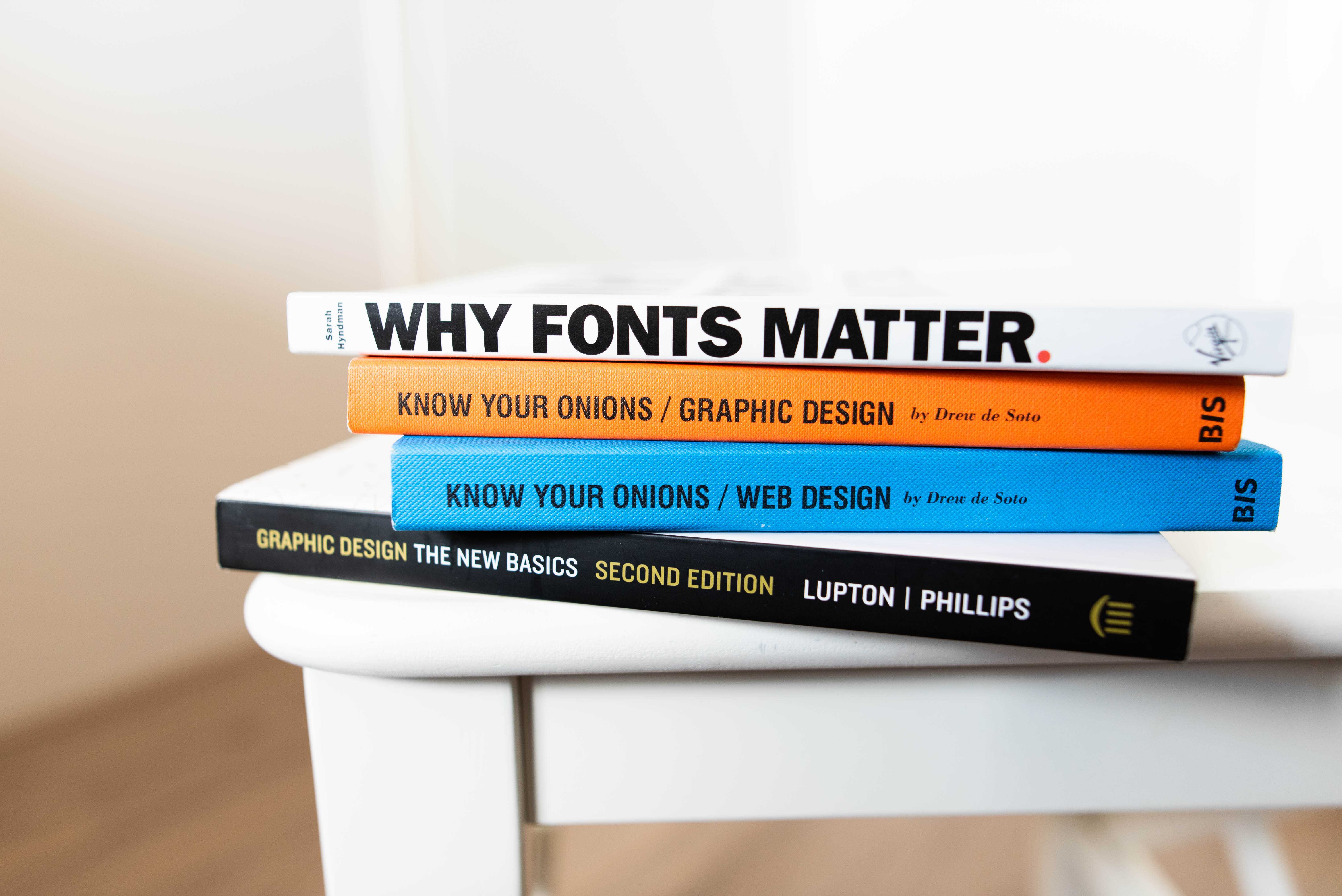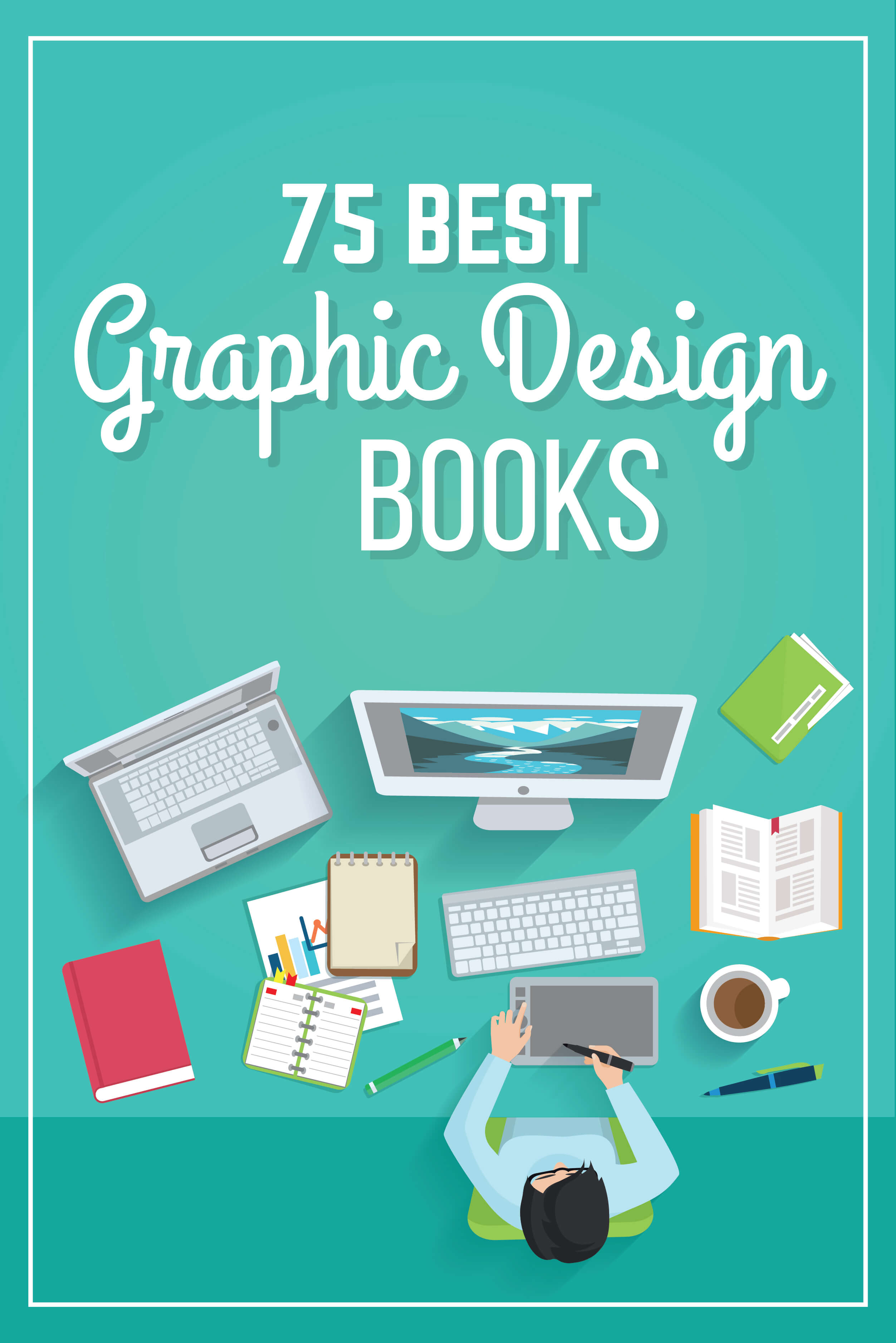

Graphic design books are published at an alarming rate but not all of them are worth your time. Don’t waste your time and cash on a book that repeats what you already know or doesn’t delve deep enough into the topic. Instead, pick up one of these “must-haves” for your creative library. We’ve divided our list into five categories for easy perusal.
How did we choose the list? First I went to the graphic design section of three bookstores in Manhattan. Then I went home and looked at the books I had on my shelf. We also asked our email list of over 20,000 graphic designers for recommendations. Finally, I cross-checked the books in Goodreads and Amazon.
Technical, stylistic, objects and methods are represented in this 100-entry reference. Authors Steven Heller and Veronique Vienne put together these ideas in chronological order for the readers’ convenience.
Students and veteran designers alike use this comprehensive reference by Robin Landa. A perfect supplement for designers that work primarily with print and screen media.
See how graphic design has changed over the years in this stunning visual history. It includes an illustrated timeline for each decade as well as industry leader profiles and landmark projects.
The historical journey through time with stunning visuals continues in this second volume. Students and professionals may use this as a reference or draw inspiration from the ideas of the past.
Part reference and part workbook, this “workshop” by David Sherwin helps you develop your design skills. Never let a tough design problem or deadline constrain your creativity again.
Updated for the digital age, this reference book is one that every graphic designer should have on their shelf.
Designers get inspiration from the most unlikely places. This book teaches you to embrace the influence around you with exercises, examples, and illustrations.
A guidebook for freelance designers, this reference includes information on pricing, copyright registration, and more. Expand your design business like a seasoned pro with this indispensable all-in-one reference.
Do you want a graphic design mentor at your fingertips? Author Drew de Soto gives you tips and knowledge as well as blank pages to tailor your reference book for your individual needs.
Denise Bosler’s book teaches you the rules of graphic design and the different ways to break them. In addition, there are sections specifically for designing posters, logos, publications, websites, and more.
“Where do you find inspiration”? This book answers the question with a collection of stories, case studies, and lessons.
A must-have text for students and professionals alike on using grid systems and working on a conceptual level.
A collection of postwar American typography and design from Bill Rose for any artist or lover of this aspect of American culture.
Fill your knowledge gap with personal stories and works from 75 of the most influential designers in the world. The book is arranged in chronological order so that you can see the developmental changes in design.
Design can go beyond the visual. This book explores how sound, light, space, and materials can culminate in a sensory experience.
Victor Papanek’s classic book on design has been translated into 23 languages. In this edition, he talks about creating responsible and sensible designs in a social context.
Creativity can come from anywhere. But getting noticed is another necessary step. Author Austin Kleon talks about how to get noticed and “findable” through self-discovery.
A fresh exploration of a classic and essential text. This book explores design principles and how to work with grids. The new edition includes updated text and photos as well as international graphics.
Find out what 50 graphic designers feel about their education and where they are in their profession. A rare peek into the world of graphic design, this book is filled with advice and warnings for anyone thinking about a career in design.
Beyond creativity is the practicality of getting your business off the ground. This book by Douglas Davis strives to fill that void of business skills some creative thinkers may lack.
Contains practical, real-world advice for succeeding in the professional world of design. Learn the professional do’s and don’ts that took other design professionals years to acquire in this witty but practical guide by Michael Janda.
When is it time to team up? Can you go it alone? Being creative doesn’t mean one career path. This book explains your choices and what to do to forge your own path. A good option for both seasoned professionals looking for something new and new grads starting a career.
Whether you’re new to the design industry or a seasoned veteran, this irreverent guide can help. With straight talk about a variety of subjects from education to personal development, get insightful answers to important questions.
A perfect gift for the young professional just starting out. It’s filled with practical advice and philosophical guidance for everything from setting up to collaborating with clients.
Words communicate in different ways. And graphic designers know that typography can convey more than the words themselves. This book helps with everything relating to type.
If you want to know how to move past the traditional rules-based approach to typography, this may be a good option. It moves typography into a modern context with influences in medium, audience, and message.
Print work may be a dying art, but this specialization is not going away anytime soon. Specialists in print production may find this book informative.
Spark a conversation with fellow letter lovers! This book gives an overview of over 300 years of typeface design and graphic styles.
Professionals and hobbyists can benefit from some extra typography inspiration. This book gives a basic overview of design principles as well as intermediate level lettering.
Designs that translate into other cultures and across the globe can be a challenge. This book strives to help with the problem of using two or more writing systems and integrating them into visually stunning designs.
Author Denise Bosler explores the essence of type and its relation to other elements. Filled with instructions as well as real-world inspiration and interviews, this book gives designers a different perspective on typography.
Take a look at how Futura has seeped into cultural icons and historic moments. Anyone interested in reading about how typefaces convey meaning and become its own language may want to check out this book.
How do typography and design help sci-fi films transcend the screen? This book studies classic films to discover the inspiration and design tricks that made sci-fi movies so believable.
Need a little letter inspiration? This book illustrates technical points without descending into jargon. Draw inspiration from the masters or gift it to your favorite creative designer.
This book is part of Jim Krause’s series, Creative Core design fundamentals. It takes the reader through typography basics for beginners as well as pros in need of a refresher course.
A brief visual history of type since the advent of the first printing press to the modern day. Over 320 typefaces included with brief histories for each entry.
This style guide is by renowned typographer Robert Bringhurst. This highly technical book has a wealth of information on layout and typography.
A collection of explorations into typography by 90 of the world’s leading typographers and designers. A must-have in any design enthusiast’s collection.
For typographers who need polished documents. The right type isn’t just for flashing advertisements. Designers that work with lawyers may find this book very informative.
If you use InDesign for print ads and such, you may want to add this book to your collection. Covering macro and micro typography and capabilities in the program, you can make the most of Adobe’s toolset.
A book that specializes in better typography for website use. The casual voice and live code examples make this an indispensable resource for web developers and designers.
A reference for those who use typography in their designs. Covering type from print to the web, this revised edition from Ellen Lupton is a great addition for anyone who works with words.
An A to Z survey of who’s who in contemporary typography. Includes examples from over 100 designers. Find your heroes or discover someone new.
Look into this fresh approach to hand lettering with examples from over 100 artists worldwide. These examples move away from traditional pen calligraphy using creative approaches and different approaches.
Inspiration and workbook meld together with this collection from well-known type designers. It features real-world projects as well as sketchbooks and interviews.

Understand the science behind fonts and how it can influence what you read as well as evoke different emotions. This book by graphic designer Sarah Hyndman talks about how her typographic research ties in with experimental psychologists and neuroscientists’ findings.
An essential addition to any word geek’s library. Simon Garfield explores the world of fonts and seeks to answer some pressing questions behind the world’s most popular fonts and their impact on what we read.
Available in leather bound and paperback versions, this new rule book covers crossover classic typography rules for layout designs on a computer.
A survey of Aaron James Draplin’s work. Includes case studies, road studies, advice, how-to’s, as well as examples of his work.
Profiles of over 60 designers that shaped and invented Midcentury Modern graphic design style in the United States.
Learn how to express complex ideas effectively with the right images. Contains 200 graphics projects with over 400 examples.
A visual history of over 500 automobile brochure reproductions. A great addition for designers in need of quick inspiration.
Leatrice Eiseman and Keith Recker identify touchtone works and match them with official Pantone color palettes to show trends, shifts, and resurgences in color.
Color goes hand-in-hand with design. And Aaris Serin’s book helps designers communicate and integrate color into different design types.
Josef Albers’ handbook on color theory principles may be old but the information is still essential. Covers color principles like color intensity, relativity, and temperature.
A noteworthy read for any designer, this book is filled with fascinating projects and insight from design genius Stefan Sagmeister. This book is one of three books that Sagmeister has out.
A monograph by Emily King of the famous design team Michael Amzalag and Mathias Augustyniak. It’s part visual history and part inspiration for any designer’s coffee table.
In need of inspiration? Pick up a copy of this stunning visual guide to comics with some amazing and cleverly done infographics. Comic and designer geeks alike may like this clever guide.
Graphic designer Michael Bierut’s monograph, design manual, and manifesto all rolled into one compelling book. Put it on the coffee table for a great conversation starter or inspiration.
A resource for designers who work with color. Cultural and historical context is included, but unfortunately, RGB values are only suitable for print.
A collection of stories, artwork, anecdotes and inspiration from renowned graphic designer Jon Contino. Find out what made this minimalist artist tick and what inspired him for some of his well-known works.
Freelance illustrator and artist Ben Tallon’s account of starting out in the creative industries and making a name for himself as a freelancer.
Get inspired by newspaper designs of yesterday. This book features designs from the Guardian, the New York Times, and Liberation. Follow the artistic shift from print to digital art with visual examples of some of the best news designs.
Part visual history and part inspiration from this country that’s shrouded in secrecy. From hotel brochures and luggage tags to packaging and tickets, this is an interesting addition to any designer library.
Create a successful brand in five and a half simple steps. Using case studies and illustrations from current brands, this book helps readers create compelling brands.
A multilingual catalog of modern trademarks from 1940 to 1980s. Be inspired or do a little research for your branding project with logos from the past.
Develop an iconic brand from start to finish with David Airey’s guide. A good option for designers who work with businesses or those curious about doing so.
Part visual history and part coffee table staple, this book by Rian Hughes is a good source for inspiration and discussion.
A collection of over 1,300 typographic identities across the world. This handbook may be an indispensable resource for design studios that work on corporate and branding projects.
Whether you’re in charge of your design team or you need to rebrand your corporate identity, this book gives you the essential tools you need to see it done.
Small businesses start up all the time. And they may make up the bulk of your freelance business. This book has copious branding examples to draw from. And an excellent addition to any designer’s library.
Corporate entities aren’t the only ones that need the right branding. This book offers ideas and inspiration for your food and beverage branding clients.
Over 200 pages of insight into making dynamic identities. A good read for anyone who works with branding and marketing.
This handbook helps designers balance creativity with marketing to design great brand identities. The book includes exercises and examples for creating successful brand identities, including creating mood boards, defining the audience, and analyzing competitors.
Written by designer David Airey, this book helps formalize the process of brand identity design. It takes the reader through important steps like defining a strategy, conducting research, and developing touchpoints.

You may already have some of these books in your personal library. But as your needs change in your profession, so will your reading material. This list has made it a point to cover many creative professional needs.
Whether you’re just starting out or you’re a professional who wants to brush up on skills, there’s a book here for you. And don’t forget to check out the books on history and other designer works. Inspiration comes from many places. You never know if the next book you pick up can lead to your next big idea.
The Daily Logo Challenge is supported by readers. As an Amazon Associate I earn from qualifying purchases. If you click on links on our site it is possible we will earn an affiliate commission. This helps pay for the costs of the logo challenge.